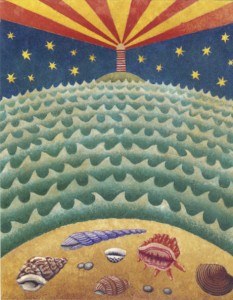But I NEED It!
 The next link in the chain of Dependent Co-Arising is upadana, usually translated as “clinging.” The previous link, “craving,” has a directional momentum to it, and when that impulse to move becomes intense (which it almost always seems to do), craving turns into “clinging.”
The next link in the chain of Dependent Co-Arising is upadana, usually translated as “clinging.” The previous link, “craving,” has a directional momentum to it, and when that impulse to move becomes intense (which it almost always seems to do), craving turns into “clinging.”
Clinging to sensuality or sense objects is one of the ways we create suffering for ourselves. Christina Feldman says, “Pleasant feelings, rather than satisfying us and making us feel this way or that, often produce a desire for more as well as a desire to hold on, which in turn creates more clinging.”
But the feeling that this is something I need is pretty convincing.
Christina goes on to say, “I think there’s an easy way to distingue between craving and valid need, and this is that one can be satisfied and the other can’t. If you’re very hungry and you eat, it’s enough, right? The hunger is gone and you move on. If it’s an insatiable hunger, say, or addition to food, that’s never satisfied.
“If you have a valid need to eat, sleep, to be sheltered…your pathway is often very clear. It’s not complicated. But that doesn’t seem to be true of craving. There’s a kind of floundering, obsessiveness, busy-ness around it. It’s not so simple.”
Upadana is also translated as “grasping,” or “attachment.” But I like the literation of “craving” and “clinging,” so for the DPP homework, I’ll stick with “clinging.”
(image: Tarot of the Witches)
THIS Will Make Me Happy
 The next link in the chain of Dependent Co-Arising is tanha, usually translated as “craving.” This is the point where “Ah, this is pleasant,” turns into “I want more!” (Or “Yuck, this is unpleasant,” turns into “Get that away from me!” Or “Hmmm, this isn’t pleasant or unpleasant,” turns into “BORING!”)
The next link in the chain of Dependent Co-Arising is tanha, usually translated as “craving.” This is the point where “Ah, this is pleasant,” turns into “I want more!” (Or “Yuck, this is unpleasant,” turns into “Get that away from me!” Or “Hmmm, this isn’t pleasant or unpleasant,” turns into “BORING!”)
Christina Feldman says, “It is at the point where craving arises in response to pleasant or unpleasant feeling that our responses become very complex. And it’s also a place where we run into a world of struggle. The important thing to remember is that craving is also a kind of moment-to-moment experience; it arises and it passes.
“Within our condition it becomes the foundation of developing specific attitudes and values…So we say, ‘This has the power to make me happy.’ Or ‘This has the power to make me unhappy. If I get this thing or I get this meal or I get this experience, then I’m going to be happy. If I don’t get it, or if I get something that I don’t want, then of course I’m going to be unhappy.’
“So what happens through craving is that in a way we delegate authority to an object or to an experience or to a person. And of course, in delegating authority or power to that separated entity, something else is happening at the same time, namely that we are depriving ourselves of authority. As a result, our sense of well being, our sense of contentment or freedom comes to be dependent upon what we get or don’t get; or our success in being able to get or to get rid of that element…
“And yet this never ends because the promise is never fulfilled. As you know from your own experience, we get the thing we thought we always needed to make us happy, and then we lose interest in it, or get bored. So in a way there’s a kind of anxiety generated through ignorance and through the sense of separation which can never be satisfied…
“You all know that kind of restlessness of appetite–there’s never enough; just one more thing is needed; one more experience, one more mind state, one more object, one more emotion, and then I’ll be happy….Here we are dealing with a basic, never-ending hunger.”
Tanha is sometimes translated as “emotional urge,” “desire,” or “unquenchable thirst.” I like “unquenchable,” but for the homework assignment, I’m going with simple “craving.”
(image: Housewives Tarot)
Ouch.
 The next link in the chain of Dependent Origination/Co-Arising is vedana, which is almost always translated as “feeling” or “feeling tone.” This is not “feeling” in the way we “feel” our emotions. It’s in the way we “feel” the impact of a sensation as it comes into contact with awareness.
The next link in the chain of Dependent Origination/Co-Arising is vedana, which is almost always translated as “feeling” or “feeling tone.” This is not “feeling” in the way we “feel” our emotions. It’s in the way we “feel” the impact of a sensation as it comes into contact with awareness.
Vedana is a simple, feeling response to contact (phassa), and it is always either pleasant, unpleasant or neutral. (“Neutral” is more accurately “neither-pleasent-nor-unpleasant.”)
The image I chose here looks like the feeling tone is always unpleasant, but that’s because I want to keep in mind that even pleasant sensations….the taste of really good dark chocolate, for example, or a beautiful sunset, or the touch of a baby’s skin….even these lovely sensations have the potential for pain, if we cling to them and keep wanting more. Neutral sensations also have this potential, because we tend to space out when they’re present and not notice what’s going on.
Christina Feldman says, “It is important to acknowledge that the links of contact, of sense doors and feeling that we are talking about are neither wholesome nor unwholesome in and of themselves, but become the catalyst for what happens next. The sense doors, the feelings and the contact are the forerunners of complexity. They are the forerunners of how we actually react or respond, and how we begin to weave a personal story out of events or impressions that all of us experience at all times.
“Therefore contact, feeling and sense doors are pretty important places to pay attention to. Because it’s when we move on to the next link of craving that we begin to see more precisely the process of suffering and complexity that begins to emerge.”
Vedana can also be translated as “sensation,” but for the DPP assignment, I’m going with “feeling tone.”
(image: Napo Tarot)
Bingo!
 The next link in the chain of Dependent Origination (also called Dependent Co-Arising) is phassa, most often translated as “contact.”
The next link in the chain of Dependent Origination (also called Dependent Co-Arising) is phassa, most often translated as “contact.”
This is the point when a sensation from the eyes, ears, nose, tongue, skin…or thoughts, ideas, images, etc. from the mind….come into contact with awareness.
Christina Feldman says, “Contact is the meeting between the sense door and the sense information–I ring the bell, hearing arises. You have an itch in your body, your body consciousness arises. You smell something cooking in the kitchen, the smell sense door arises. This arising always involves the coming together of the sense door, the sense object and consciousness. Those three elements together is what contact is.
“The Buddha once said that with contact the world arises. And with cessation of contact there is the cessation of the world. It doesn’t mean wipe-out. What it means is that there’s a cessation of the world that is perceived according to sankharas (habitual patterns of thinking, feeling, etc.) and ignorance. There’s cessation of a ‘personal’ perception of the world.
“Each moment of contact is the isolating of an impression out of the whole stream and presence of impressions that are present for us in every moment. There’s a vast number of impressions/phenomena going on. Contact is what happens when something jumps out of that background and becomes foreground. We’re paying attention to it. There’s that meeting of the sense object, the sense door, and consciousness. The sensation stands out for us. That is contact.”
Phassa is sometimes translated as “sensory impingement” or “sense experience.” But I like the immediacy of “contact,” so for the DPP homework, I’m going with that.
(image: illustration by George Willett from “Creative Whack Pack.”)
What Comes Through the Door
 Christina Feldman says: “In classical presentations, the process of Dependent Origination is comprised of twelve links. It is important to understand that this in not a linear, progressive, or sequential presentation. It’s a process always in motion and not static at all. It’s also not deterministic. I don’t think that one link determines the arising of the next link. But rather that the presence of certain factors or certain of these links together provide the conditions in which the other links can manifest…It’s a bit like a snowstorm–the coming together of a certain temperature, a certain amount of precipitation, a certain amount of wind…co-creating a snow storm.”
Christina Feldman says: “In classical presentations, the process of Dependent Origination is comprised of twelve links. It is important to understand that this in not a linear, progressive, or sequential presentation. It’s a process always in motion and not static at all. It’s also not deterministic. I don’t think that one link determines the arising of the next link. But rather that the presence of certain factors or certain of these links together provide the conditions in which the other links can manifest…It’s a bit like a snowstorm–the coming together of a certain temperature, a certain amount of precipitation, a certain amount of wind…co-creating a snow storm.”
That said, the next “link” in this chain of conditions is called salayatana, which translates as “the six sense bases” or “fields of sense experience.” In Buddhist terms, these six are the five physical senses (sight, sound, taste, touch and smell) plus the mental “sense” of mind, which includes thoughts, memories, images, ideas, etc. Metaphorically, these sense organs are considered “doors” through which sense impressions (sights, sounds, tastes….as well as thoughts and ideas) come into awareness. So just as the eye is the receptor for sight sensations, mind is the receptor for thought sensations.
Sense “bases” doesn’t have a lot of meaning for me. I like the idea of doors opening up to let sensations come into awareness, so for the homework assignment, I’m going with “sense doors.”
(image: Q-Cards by Zolo Inc.)
The Arising of Body and Mind
 The next link in the chain of Dependent Origination is nama-rupa, which usually is translated either as “name-and-form” or “mentality-materiaity.” Christina Feldman uses “mind-and-body.” She says, “Nama, or ‘mind,’ describes the feelings, the perceptions, the intentions, the kind of attention that we give to what appears in the field of our awareness.” So nama is the whole movement of mind in all its components in relationship to the “body” of physical/material phenomena (rupa). The way it works is that “there’s the arising of rupa and then nama creates concepts or attitudes about it.
The next link in the chain of Dependent Origination is nama-rupa, which usually is translated either as “name-and-form” or “mentality-materiaity.” Christina Feldman uses “mind-and-body.” She says, “Nama, or ‘mind,’ describes the feelings, the perceptions, the intentions, the kind of attention that we give to what appears in the field of our awareness.” So nama is the whole movement of mind in all its components in relationship to the “body” of physical/material phenomena (rupa). The way it works is that “there’s the arising of rupa and then nama creates concepts or attitudes about it.
Christina continues, “The kind of relationship we have with any rupa, including our own body, is shaped by what’s going on in the mind, whether we are aware of it or not.
“So the shape of the mind and body, this nama-rupa, is always changing, always moving, never staying the same. Consciousness, body and mind are always interdependent. Consciousness leads the body and the mind to function in a certain way. If consciousness has arisen flavored by anger or by greed, by depression, by anxiety…or whatever…it provides the conditions for the body and mind to organize itself in a particular way. We can have a sad body, an angry body, a fearful body….and that sense of body is not only what is happening physically, but also what is happening in the mind.”
I like the simplicity of “mind/body” as translation for nama/rupa, but it’s not just our own mind and body that we’re talking about. It’s all the forms that appear in awareness, and the mental response we have to them. I prefer “mentality/materiality,” but it’s too much of a mouthful. I’m tempted to go with “things-and-thoughts,” for the alliteration if nothing else. But that suggests too much of a split. The physical “thing” is inseparable from our mental response to it. (As in the image I chose of the moon and its reflection.) I like the way nama suggests “name,” so for the homework assignment, I’ll go with “name-and-form.”
(image: Maddonni Tarot)
Flavor of Mind
More on the DPP homework topic of Dependent Origination
 Consciousness (vinnana) is the third link in the chain of Dependent Origination. Christina Feldman says that consciousness “describes the basic climate of the mind at any particular moment–the way the mind is actually shaped, flavored, at any moment…whether it’s aversive or dull or greedy.”
Consciousness (vinnana) is the third link in the chain of Dependent Origination. Christina Feldman says that consciousness “describes the basic climate of the mind at any particular moment–the way the mind is actually shaped, flavored, at any moment…whether it’s aversive or dull or greedy.”
She goes on to say that consciousness also begins to shape how we see the world. As a faculty, consciousness is flavored, so the same object will appear differently to different people, depending on each person’s consciousness and the sankharas (habit patterns) that are present. AND, because everything is interconnected, consciousness is also shaping what is around us. For example, people respond to us differently when we’re angry than when we’re afraid or welcoming or giddy or sad.
“Consciousness” is the usual translation for vinnana. But I find it helpful to think of mind as being shaped with a kind of “flavor,” depending on circumstances….so for the homework assignment, I’m translating vinnana as “flavor of mind.”
(image: Steampunk Tarot by Curly Cue Design)
Making Waves
 Continuing from yesterday’s post on Dependent Origination:
Continuing from yesterday’s post on Dependent Origination:
One of the DPP homework readings is a transcript of a talk given by Christina Feldman, in which she explains sankhara as “the way ignorance takes form, takes a particular shape or a particular activity–almost the way it rises out of being invisible or unconscious into a more generated or active form that can actually be seen–in body, speech, or mind.”
Sankhara is usually translated as “volitional formations,” but what the heck does that mean? In Kamma and the End of Kamma, Ajahn Sucitto describes sankhara as “behavioral patterns or programs,” and in a recent series of talks I’ve been listening to lately, he uses emotional and psychological “wave formations.” Which I really like because it’s so visual.
As I understand it, sankhara are “things/processes that have come together as a result of past actions, intentions, habits, preference and opinions.” It’s not the most elegant translation, I’ll concede. So I think for the homework assignment, I’ll go with “mental, verbal and bodily wave patterns.”
(image: this is from another one of those cards I’ve had in my desk for years. I have no idea who to credit.)
Not Knowing
 The main topic of the DPP homework for this month is Dependent Origination (paticca samuppada), which is the Buddha’s unique teaching that describes how, out of ignorance, we continue to get caught in suffering over and over again.
The main topic of the DPP homework for this month is Dependent Origination (paticca samuppada), which is the Buddha’s unique teaching that describes how, out of ignorance, we continue to get caught in suffering over and over again.
Let me just say that this is not a simple, intuitive teaching. Which is why we have already spent a great deal of time working on it. This month, part of our homework is to look at the 12 links that make up the chain of Dependent Origination, to consider the various translations of the Pali terms for these links, and then to create a personal list that works for us. (And to find images that represent each of these terms.)
The 12 links are:
Avijja…ignorance, blindness, unconsciousness
Sankhara…karma-formations, patterns and programs, volitional formations
Vinnana….consciousness, cognition, knowing
Nama/Rupa….name/form, mentality/materiality, mind/matter
Salayatana….six senses, sixfold sensory experience, realm of the senses
Phassa…contact, sensory impingement, touch
Vedana….feeling, sensations, sense experience
Tanha…craving, emotional urge, hunger/thirst
Upadana….grasping, clinging, attachment
Bhava….becoming, being
Jati…birth
Jaramarana…aging and dying, old age and death, grief, sorrow, suffering, lamentation and despair
Today, I’m working on avijja. I think I’m going with “not knowing“ as my personal translation.
(image: this illustration is from a tarot deck I’ve had in my collection for years….but I’ve lost the box, so I’m in a state of not-knowing as to the source)
There Is A Seed
 “Though I do not believe a plant will spring up where no seed has been, I have great faith in a seed. Convince me that you have a seed there, and I am prepared to expect miracles.” — Thoreau
“Though I do not believe a plant will spring up where no seed has been, I have great faith in a seed. Convince me that you have a seed there, and I am prepared to expect miracles.” — Thoreau
One of the topics for this month’s DPP homework is saddha, a Pali word which usually is translated as faith….a word that, at least for me, comes with an awful lot of baggage. Saddha is also translated as confidence, conviction, or trust….which I prefer….but there is a kind of power in the word faith….especially when I think about having faith in a seed….that I don’t want to lose.
Here’s part of this month’s focus on faith:
“Saddha, usually translated as faith, is an essential ingredient in the spiritual journey. In the Buddha’s teaching, it is one of the five spiritual faculties necessary for true understanding and awakening, along with energy, mindfulness, concentration, and wisdom.
“Faith is usually placed first because it fuels the whole process. Likewise, doubt (the lack of faith), is the most formidable of all hindrances because it stops us from ever beginning. We are frozen out of even stumbling onto understanding because we never practice in a manner that allows the truth of the dharma to be known. For this reason, a certain amount of faith is not an option, but a necessity.
“Faith requires at a minimum an acknowledgement that the fruit of the dharma (the end of suffering) might be true, and it may be possible that even we, with all our flaws, might experience this fruit. It also requires an acknowledgement that the possibility of attaining such a fruit is worthy of great effort.
“Notice that faith does not require a belief in some force outside ourselves, but rather a realization that we suffer and it might be possible to have it end.
“It creates an unhealthy and unproductive tension to try to force more than this minimum amount of faith. Faith grows because of the insights we have and from our intuitive recognition of the truth of the teachings. As recognition occurs that the teachings are essentially true, faith grows stronger on its own accord.
“At some point a love of the dharma or the Buddha or the sangha naturally occurs. At this point, there is a heartfeld dimension to the practice, a natural devotion.”
***
Of this much, I am sure.
